Aviation against tanks (part of 3)
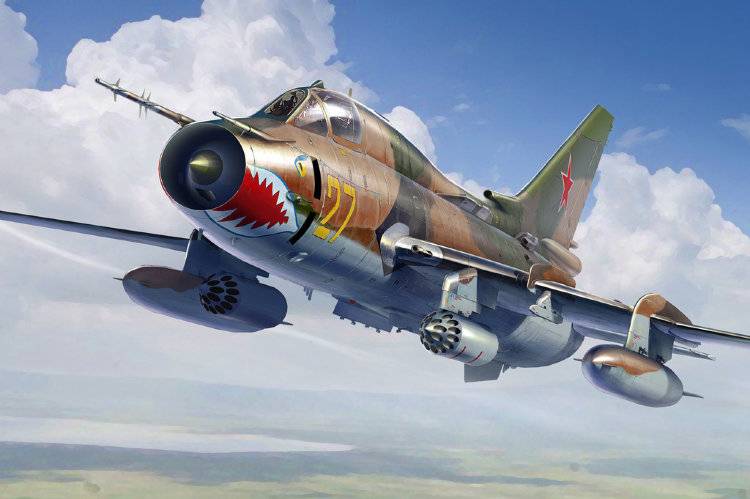
After the war, the USSR continued to work on new armored attack aircraft. Simultaneously with the creation of fighters and front-line bombers with turbojet engines, the design of attack aircraft with piston engines was carried out. In comparison with the Il-10 and Il-10М that were already in service, the designed attack aircraft should have more security, increased firepower and better forward-down view. One of the main drawbacks of the Il-2 and Il-10 attack aircraft was the large, unseen dead zone created by the engine hood, which in turn made the targeted bombing of pinpoint targets difficult.
20 November 1948, the first flight of an experienced attack aircraft Il-20. The aircraft had a very unusual appearance, the cockpit was located above the M-47 liquid-cooled piston engine with a nominal horsepower 2300. Between the pilot and the shooter, in whose possession there was a turret with a 23-mm gun, was placed the main fuel tank, covered with double 8 mm armor.
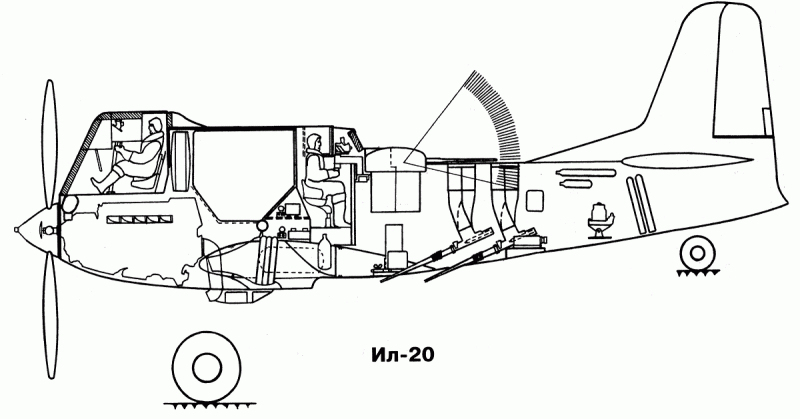
The cockpit and arrow, engine, cooling system, fuel and oil tank were located inside the armored box. The total weight of the metal and transparent armor was more than 2000 kg. Compared to IL-10, the thickness of metal armor increased on average by 46%, and transparent - by 59%. The armor mounted on the IL-20 protected not only from the 12,7-mm caliber armor-piercing bullets fired from the 300 meters, but also to a large extent from the 20-mm projectiles. The front of the cabin began immediately after the trim of the screw bush. The long frontal armored glass 100 mm thick, set at an angle of 70 °, provided an excellent forward-down view of the 37 ° sector, and when diving at 40-45 °, the pilot could see targets almost directly under the plane. Thus, on the IL-20 was eliminated one of the main drawbacks that exist in the design of armed attack aircraft.
According to the project IL-20 was supposed to have very powerful weapons. The bomb load reached 700 kg (according to other 1190 kg data). The offensive weapon in the first version included two wing guns of the 23 mm caliber for firing forward and two 23-mm guns mounted in the fuselage at an angle of 22 ° - for firing at a strafing flight. Under the wing, the suspension of four 132-mm TRS-132 rocket launchers launched from the ORO-132 tubular "guns" was provided for.
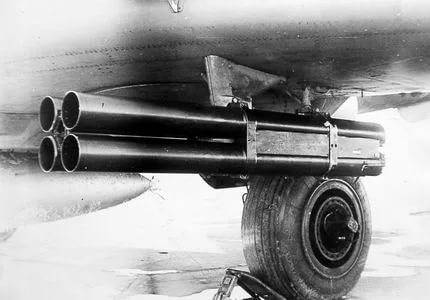
When designing the TPC-82 and TPC-132 missiles traditional for the Soviet 82 and 132-mm calibers, an attempt was made to reduce drag in the aircraft and to improve the accuracy of fire due to the rotation of the shells on the trajectory. The speed of rotation of the TRS-132 reached 204 rev / sec. At the same time, the accuracy of shooting really increased, but it was still not enough to confidently hit a single tank. In terms of their amazing characteristics, TRS-82 and TRS-132 were approximately at the level of PC-82 and ROFS-132.
The second version of weapons designed to combat tanks, consisted of a 45-mm gun NS-45, two 23-mm guns and six RS. Things did not come to the construction and testing of the prototype with a 45 mm cannon, but it can be assumed that, thanks to a much better overview and more favorable conditions for aiming, the accuracy of large-caliber fire aviation guns mounted on the IL-20, could be significantly better than on the IL-2 with two NS-37.
The aircraft with a take-off weight of 9500 kg at the ground accelerated to the speed of 450 km / h, at the height of 3000 m - 515 km / h. In general, this was quite enough for the anti-tank aircraft and attack aircraft, acting in the interests of direct aviation support. However, the military, spellbound by the high speeds of jet planes, considered these characteristics insufficiently high and the work on the IL-20 turned down. Among the shortcomings of the IL-20 was uncomfortable access to the engine, which was the result of its unusual layout.
The transition of combat aircraft to jet engines and the experience of air battles in Korea predetermined the creation of a domestic attack aircraft with turbojet engines. In April, the 1954 of the year successfully completed state tests of the Il-40 attack aircraft, and in October, the 1955 of the improved version of the IL-40П.
An assault plane with a normal take-off weight of 16600 kg, equipped with two turbojet TRD engines RD-9В with a nominal thrust of 2150 kgf, on tests showed the maximum speed of 993 km / h, which was not much less than the speed of the MiG-15 fighter. Normal bomb load - 1000 kg (in overload 1400 kg). In the four internal bomb compartments could be placed bombs weighing up to 100 kg or fragmentation and anti-tank bombs. Combat radius - 400 km. The offensive armament consisted of four X-NUMX-mm AM-23 guns with a total rate of fire of 23 rpm and eight launchers for the TPC-5200. The rear hemisphere was protected by one remote-controlled 132-mm gun. During the shooting at ground targets, the IL-23 was more stable in control than the IL-40M, which had a positive effect on the accuracy of the fire. Simultaneous firing of all four guns did not affect the piloting of the aircraft, the recoil when shooting was small.
Training air battles with the MiG-15bis and MiG-17F fighters demonstrated that the IL-40 is not an easy opponent in aerial combat. Firing on it is difficult due to the large horizontal and vertical velocities of the IL-40, their wide range. Thanks to the effective air brakes of the attack aircraft, the attacking fighters jumped forward and were themselves hit by powerful offensive weapons. It was also not worth to discount the fire capabilities of the defensive remote-controlled turret. All this gave good chances to survive when meeting with enemy fighters. The armor protection of the crew and vital components and assemblies approximately corresponded to the level of protection of the IL-10M, which in turn was more perfect than on the IL-2. The significantly higher flight speed of the IL-40, compared with piston attack aircraft, made it possible to quickly leave the zone of anti-aircraft fire. In addition, the twin-engine aircraft could continue flying if one turbojet engine failed.
In combat capabilities, the IL-40 was significantly superior to the IL-10M piston attack aircraft, which was in service with the Air Force at that time. IL-40 could develop a greater maximum speed of horizontal flight, climb rate, altitude, had a greater range of speeds, won by bomb load and power weapons. It would seem that with such characteristics a rocket attack aircraft had a cloudless future, but different times came, and the top military-political leadership relied on the missiles, burying many promising aviation projects.
As of 1 on January 1955, the Soviet Soviet Air Force had 19 assault air regiments armed with 1700 piston attack planes IL-10 and IL-10M and 130 jet fighter-bombers MiG-15bis. In a report presented in April 1956 by Secretary of Defense Marshal G.K. Zhukov, a groundless conclusion was made about the low effectiveness of attack aircraft on the battlefield in a modern war, and in fact it was proposed to abolish attack aircraft. At the same time, the tasks of direct aviation support for the troops were proposed to be entrusted to fighter aircraft and front-line bombers. The proposal of the Minister of Defense found warm support from the leadership of the country, and soon an order was issued, according to which, the assault aviation was abolished, and all available attack aircraft were to be written off. In parallel with the liquidation of assault aviation, the decision to establish the serial production of the jet IL-40 was canceled and all design work on promising attack aircraft was discontinued.
After the elimination of assault aviation as a class and the disposal of existing piston attack aircraft for scrap and the abandonment of serial construction, which had no analogue of the Il-40 jet attack aircraft, this niche was occupied by jet fighters MiG-15bis and MiG-17F. These aircraft had quite powerful cannon weapons and a good view from the cockpit, but did not fully meet the requirements for direct aviation support aircraft. Moreover, in the role of tank destroyers, first-generation jet fighters with a weight of 200-250 kg rocket-bomb load were ineffective. In 60-s, to increase the shock capabilities of the MiG-17F, they were equipped with NAR UB-16 units with 57-mm NAR C-5 units. In the 1960, the C-5K (KARS-57) unguided missile with the 130 mm armor penetration was adopted.
At the beginning of the 60-x to replace the MiG-17F in the fighter-bombing regiments began to arrive Su-7B. Supersonic aircraft with one engine AL-7F-1 with nominal thrust 6800 kgf, without external hangers at high altitude accelerated to 2120 km / h. The maximum combat load of the Su-7B was 2000 kg.
30-mm HP-30 guns with 70 rounds of ammunition per barrel could be used against armored vehicles. Their total rate of fire was about 1800 shots / min, that is, for one second, a barrage of 30 shells could be fired on the target. HP-30 was an effective means of defeating lightly armored vehicles, in a number of armed conflicts of them it was possible to incite medium tanks. With a carrier speed of 200 m / s, an armor-piercing projectile with a mass of 390 g, ejected from the gun barrel with a speed of 890 m / s, at the meeting angle 60 ° could penetrate 25 mm armor. The anti-tank weapons of fighter-bombers also included one-time bomb cassettes equipped with PTAB and NAR C-3K and C-5K.
Uncontrolled 160-mm cumulative fragmentation missiles C-3K were specifically designed to enhance the anti-tank capabilities of the Su-7B. With a mass of 23,5 kg, the C-3K rocket projectile carried a kg-shaped cumulative fragmentation warhead with 7,3 mm armor penetration. Usually, two APU-300U launchers with 14 guides each were suspended under a fighter-bomber. The C-7K rockets had good firing accuracy: at the 3 km distance, more than half of the rockets fit into a circle with a diameter of 2 m.
The C-3K missiles have proven themselves well during the Arab-Israeli wars, where Su-7B was used. But these NARs had a number of significant drawbacks. The placement of the herringbone missiles on the APU-14U created a large frontal resistance, and the planes with suspended launchers had significant speed and maneuver limitations. To defeat the armor C-3K had excess power, at the same time, insufficient to destroy the field fortifications. In addition, fourteen albeit sufficiently powerful unguided rockets was clearly not enough to effectively fight against tanks with their massive use. The fragmentation effect of C-3K was weak. With the explosion of the warhead formed a lot of light fragments. But lightweight high-speed debris quickly lost speed and penetrating power, which made them ineffective in dealing with manpower, not to mention the technology where weak striking elements could not penetrate the body of the car, aircraft trim and ignite the contents. NAR C-3K did not enjoy popularity in combat regiments, and their use was limited.
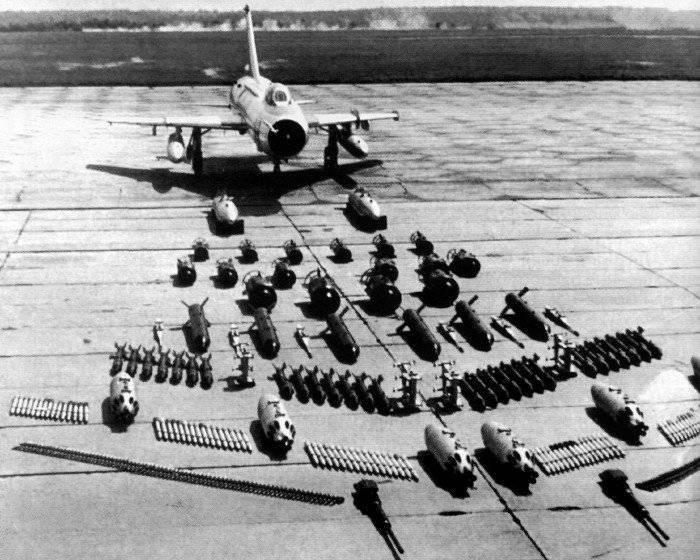
In this respect, the 57-mm NAR C-5KO with cumulative fragmentation warheads with the armor penetration of 170 mm looked much more advantageous. When crushing 11 steel rings with cuts formed up to 220 fragments weighing 2 gram. The number of 57-mm missiles with folding plumage in the UB-16 units on the Su-7BM was more than four times more than the C-3K on two APU-14Us. Accordingly, the lesion area was significantly higher. Although C-5 compared to C-3K had a less powerful warhead, they provided a sufficiently damaging effect on most targets, including armored vehicles in open positions, parking lots and in field-type shelters.
The targeting range of the NAR C-5 launch was 1500 m. Uncontrolled missiles were launched from a dive, and the current distance to the target, which served as the basis for solving the aiming task, was set automatically according to a barometric altimeter and pitch angle or manually by a pilot.
In practice, the launches were carried out, as a rule, from one set and worked out mode - a gentle dive with a speed of 800-900 km / h with a flight altitude of at least 400 m. The approach could be a low-altitude approach with a “jump” - a slide for attack and dive on the target.
Naturally, with such a speed of flight and the range of the launch of the NAR, there could be no talk of fighting against individual tanks. Even on a well-known test site, the likelihood of a successful attack from the first approach on small targets did not exceed 0,1-0,2. The strikes, as a rule, took place on clusters of enemy equipment in places of concentration, or columns on the march. The attack of tanks deployed in battle formations was a very difficult affair and often of little success.
However, Su-7B, with proper use, has proven itself very well in local conflicts. Thus, during the next Indo-Pakistani war of 1971, the Indian Su-7BMK distinguished themselves during the attack on clusters of armored vehicles. In two weeks of fighting, Indian pilots of the Sushchek destroyed about 150 tanks. In 1973, the Syrian fighter-bombers using PTB-250 bombed cassettes and C-2,5K and C-3K missiles caused Israeli Israeli tank divisions with sensitive losses. Not bad and 5-mm "beater". HP-30 proved to be effective. weapons not only against lightly armored vehicles: in some cases, their shells destroyed medium tanks M48 and M51HV.
In 60-70-ies, in parallel with the MiG-17F and Su-7B aircraft, MiG-21ПФ / ПФМ fighters were transferred to the fighter-bombing regiments. The MiG-21PF strike armament consisted of two UB-16-57 units of 16 C-5M or C-5K shells and 50 to 500 caliber bombs. In addition, the suspension of two heavy missiles C-24 was provided.
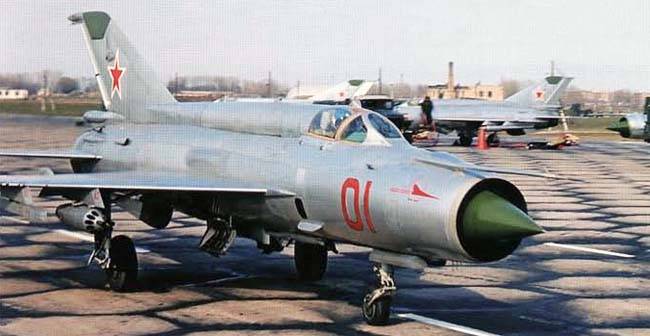
A relatively small combat load, an excessively high speed of going into the attack with a poor view from the cockpit of the existing fighter-bomber of the time forced to turn to the idea of an attack aircraft based on the IL-28 front-line bomber. In accordance with the project, the modified bomber was supposed to have the same depth of hostilities as the Su-7B, but exceed it in the number of weapons in 2-3 times. Due to the direct wing of relatively large elongation and lower flight speed, the conditions for searching for targets on the battlefield and aiming should have become better than those of a single-engine jet fighter-bomber with a large sweep wing. The advantage of the aircraft was a good overview of the cabin crew members and the possibility of combat work from unpaved airfields.
IL-28Sh with underwing pylons for the suspension of various weapons, intended for actions from low altitudes on clusters of equipment and enemy manpower, as well as on single armored combat vehicles in combat formations. 6 pylons were mounted under each wing of the aircraft on which they could accommodate: 12 units UB-16-57, suspended gun nacelles, bombs and bomb cassettes.
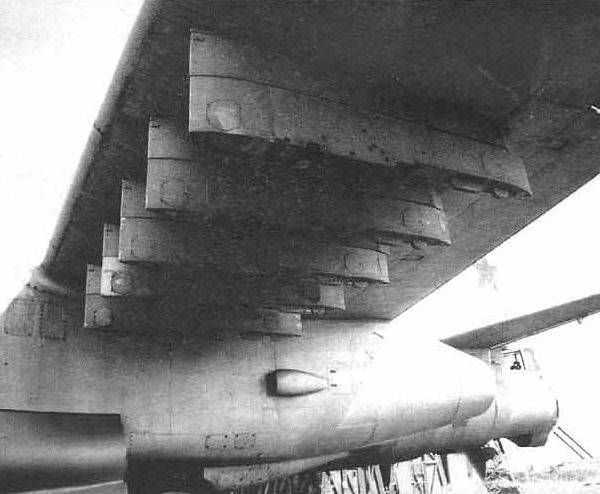
For ground targets, it was also possible to use two 23-mm gun HP-23, mounted on the sides of the bottom of the fuselage. The experience of fighting in local conflicts has shown that when the side-shooters leave the attack using the aft defensive Il-K6 installation with two HP-23 cannons, it can effectively suppress anti-aircraft fire.
The IL-28Sh tests began in the 1967 year. Numerous external suspension assemblies significantly increased the drag of the aircraft. Fuel consumption on the ground has increased by 30-40%. The combat range with a load of twelve UB-16 amounted to 300 km. According to the test pilots, the assault version of the bomber was quite suitable for the destruction of mobile small-sized targets. But the aircraft did not launch into mass production. In IL-28Sh a number of bombers were redone, happily avoiding cutting into metal during the defeat of the front aviation Khrushchev. Re-equipment was carried out during the overhaul in the factory. IL-28Sh with NAR blocks acted mainly in the bomber air regiments deployed in the Far East.
In general, the combat effectiveness of the supersonic Su-7B compared with the MiG-15bis and MiG-17F has increased significantly. But the increase in combat effectiveness of the new fighter-bombers was accompanied by an increase in take-off mass and a deterioration in the take-off and landing characteristics. The maneuverability of the aircraft at the heights characteristic of actions for the direct aviation support of the ground forces also left much to be desired. In this regard, in 1965, the creation of the Su-7B modification with a variable sweep wing began.
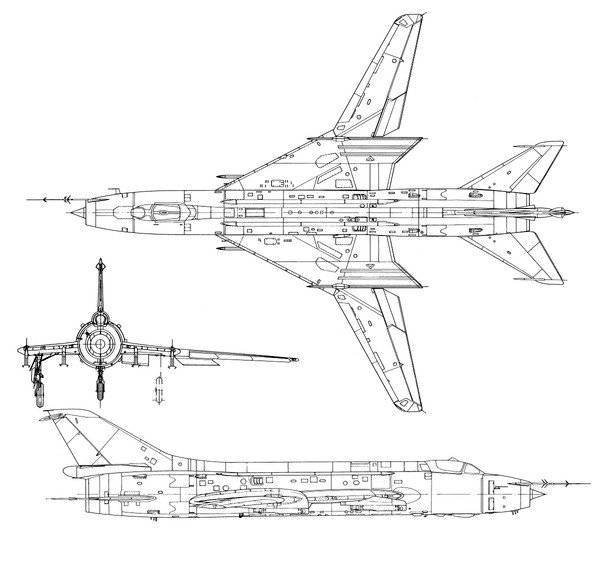
The new aircraft turned only the outer parts of the wing, located behind the main landing gear. This layout has improved takeoff and landing characteristics and improved handling at low altitudes. A relatively inexpensive upgrade turned the Su-7B into a multi-mode aircraft. The supersonic fighter-bomber, designated Su-17, was produced in large series from 1969 to 1990 year. The machine was exported under the designations Su-20 and Su-22.
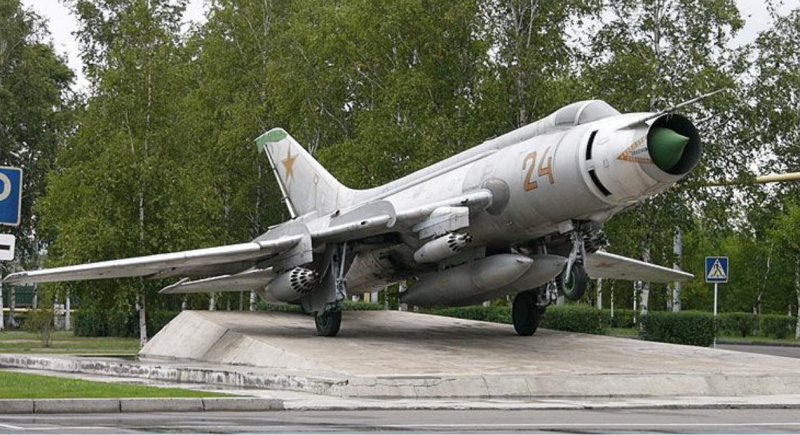
Su-17 of early modification with UB-16 and UB-32 units on the territory of an aircraft factory in Komsomolsk-on-Amur
The first Su-17 had an engine and avionics, similar to the Su-7BM. In the future, due to the installation of a more powerful TRDF engine AL-17F21 and new electronic equipment, the capabilities of the aircraft increased significantly. Following the Su-3M, modifications of the Su-17М17, Su-2М17 and Su-3М17 followed.
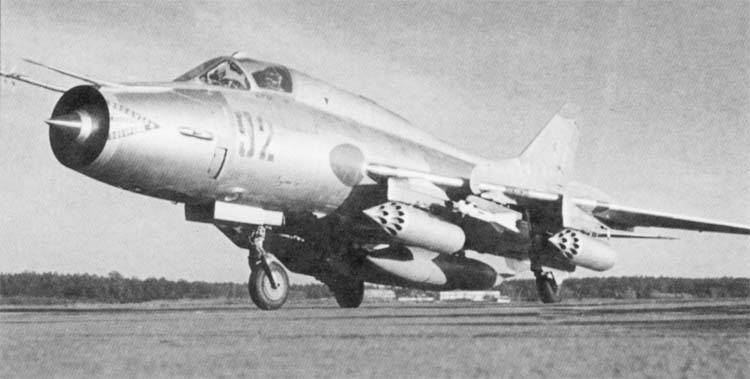
The latest, most advanced model entered the tests in the 1982 year. Given that the Su-17М4 was mainly intended for strikes against ground targets, there was a rejection of an adjustable cone-shaped air intake. The cone was fixed at a position optimal for transonic low-altitude flight. The maximum speed at the height of the limited value 1,75M.
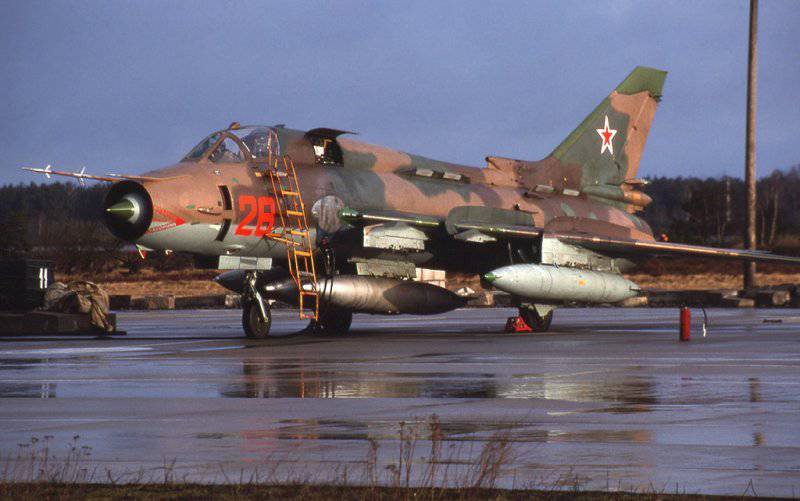
Externally, the Su-17М4 differed little from the earlier models, but in terms of its capabilities it was a much more advanced machine, equipped with the PrNK-54 airborne aim-and-navigation computing system. Compared with the Su-7BM, the weight of the maximum combat load has doubled. Although the armament included a wide range of guided bombs and missiles, they were primarily intended for the destruction of pinpoint stationary critical targets and the anti-tank capabilities of the fighter-bomber did not grow much. As before, PTAB was intended to fight tanks in one-time bomb cassettes of RBC-250 or RBC-500 and NAR.
However, the new 80-mm cumulative fragmentation of the NAR C-8KO and C-8COM had increased armor penetration and good fragmentation effect up to 420-450 mm. Cumulative fragmentation 3,6 kg of warhead contains 900 g of the explosive Gekfol-5. The range of the C-8KOM 1300 – 4000 rocket launch. M. The speed range of the aircraft carrier during combat use of the NAR C-8 of all types 160 – 330 m / s. The missiles were launched from the X-NUMX-charging launchers of the B-20M. Thanks to the introduction of the digital calculator and the Klen-PS laser rangefinder-target indicator into the Su-8М17 avionics avionics, the accuracy of NAR application has increased significantly.
According to Western data, as of January 1, 1991 of the USSR Air Force Su-17 of all modifications was equipped with 32 fighter-bomber, 12 reconnaissance regiments, one separate reconnaissance squadron and four training regiments. Su-17, despite the somewhat archaic design by the standards of the middle 80-s, embodied the optimal combination by the criterion of cost-effectiveness, which led to its widespread and long-term operation. The Soviet fighter bombers were not inferior in their percussion capabilities to similar Western machines, often surpassing them in flight data, but, like their foreign counterparts, they could not effectively fight with individual tanks on the battlefield.
Almost simultaneously with the adoption of the Su-17 on the basis of a front-line fighter with a variable geometry wing MiG-23, its attack version MiG-23B was developed and launched into a series. The impact modification of the "twenty-third" had a characteristic nose. In addition to the lack of radar, partial reservation of the cockpit, modified front end and the installation of special target equipment, according to the airframe, the aircraft differed little from the MiG-23С fighter, which has been in mass production since the beginning of 1970. To improve the forward-down view and the installation of the ASP-17 sight, the front part of the aircraft, devoid of radar, was skewed down 18 °. A good review contributed to the ease of orientation and search for goals. For a glance down there was a small heel. The pilots flying the MiG-21 and Su-7B, apart from the nose, could not be clearly seen and, in order to look around, sometimes they had to carry out the semi-halfback, turning the plane over.
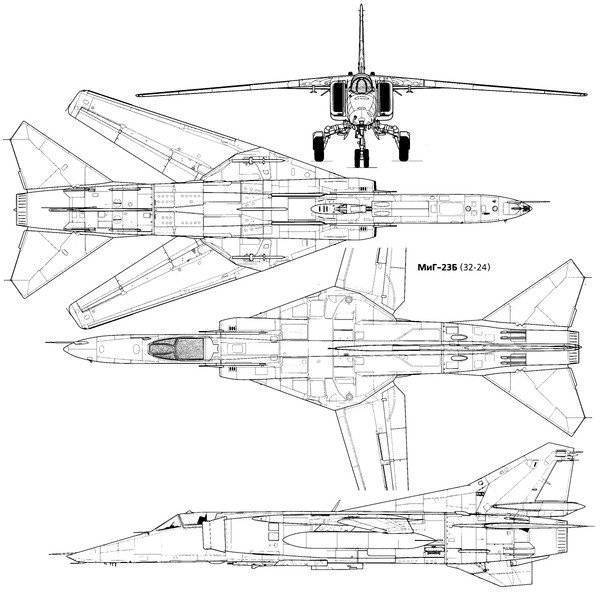
An airplane with a normal take-off weight of 16470 kg, equipped with the same AL-21F3 engine, as the later modifications of the Su-17 near the ground could accelerate to 1350 km / h. The maximum speed at a height without external suspensions was 1800 km / h. It is difficult to say what led the command of the armed forces, adopting two different types of fighter-bomber with close combat characteristics. MiG-23B had no special advantages over the Su-17, except for a better view from the cockpit. Moreover, the military rightly pointed out such shortcomings as a lower combat load per 1 per ton, more difficult piloting, worse runway characteristics, and time-consuming ground handling. In addition, just like the front-line fighter MiG-23, the shock MiG-23B with access to high angles of attack easily fell into a tailspin, which was very difficult to remove from.
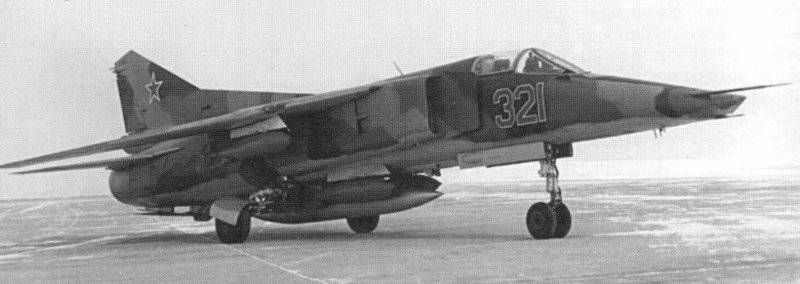
Since the weight of the MiG-23B combat load was less than that of the Su-17М, the number of anti-tank bombs in single-shot bombs dropped. In addition, on the MiG-23B installed double-barreled ventillary gun GSH-23L with 200 ammunition ammunition. With a small net weight in 50 kg, the GSH-23L had a rate of fire of up to 3200 rds / min and 10 kg with a second salvo. The GSH-23L was very effective against airborne and lightly armored targets, its 182 g armor-piercing projectiles fired at an initial speed of about 700 m / s, at a distance of 800 meters along the normal, pierced armor with a thickness of up to 15 mm. That was enough to destroy the armored personnel carrier and infantry fighting vehicles, but the armor of heavy and medium tanks from the GSH-23L was impossible to break through.
In 1973, an improved MiG-23BN with a more economical Р29Б-300 engine was presented for testing. Despite the fact that the MiG-23BN for export deliveries was built before the 1985 year, it was in many ways an interim solution, which did not satisfy both the creators and the customer. The military wanted to get a plane with increased combat effectiveness, superior to similar in purpose products of the Sukhoi Design Bureau. In this regard, work began on a radical increase in the combat characteristics of the MiG-23B.
Modernization implied changes in three directions: constructive improvements of the aircraft in order to improve flight and operational characteristics, the introduction of new target equipment and the reinforcement of weapons. The new aircraft received the designation MiG-27. Adjustable air intakes, inherited from the shock versions of fighter variants, were replaced with lightweight unregulated ones on the MiG-27, which resulted in weight savings of about 300 kg. For the sake of increasing the weight of the combat load on the new machine, the maximum speed and altitude were somewhat reduced.
Wishing to outperform the competitors of the Su-17 family, the designers relied on a new high-performance aiming and navigation system, which has repeatedly expanded the possibilities for using guided weapons. In addition, the 23-mm gun was subject to replacement. Her place was taken by the six-barreled 30-mm GSH-6-30, which has a high rate of fire and a large weight of a second salvo. The transition to 30-mm caliber, already used on the Su-7B and Su-17, provided a twofold increase in the mass of the projectile, and the increased ballistics gave not only good armor penetration and power of impact on various targets, but also significantly improved the accuracy of shooting. The GSH-6-30 on the MiG-27 was placed in the ventral niche that was not closed by the fairing, which ensured ease of maintenance and good cooling with an incoming air flow.
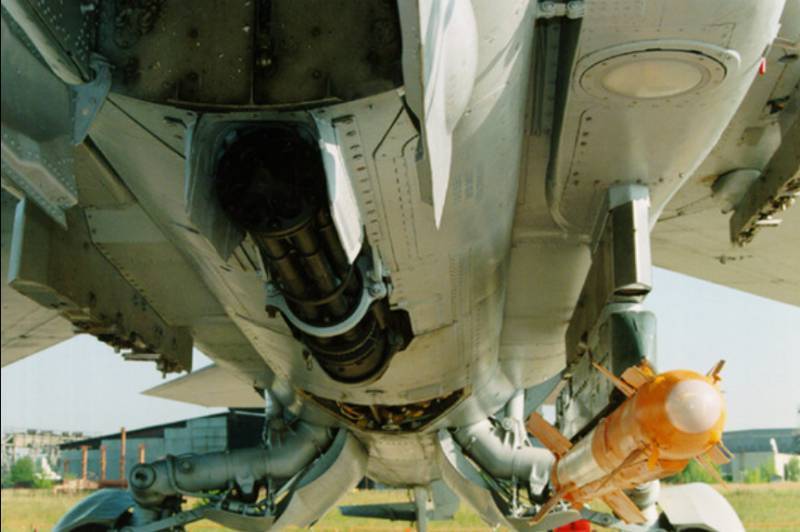
However, installing such a powerful weapon with a rate of fire of up to 5100 rds / min caused a number of problems. Often, when firing with the most powerful recoil, electronic devices were knocked out, the entire structure of the aircraft was loosened, the front landing gear flaps were jarred, which threatened to jam them. Replacing the landing lights became common after the shooting. It has been empirically established that firing a burst of no more than 40 shells is relatively safe. In this case, in tenths of a second, the gun sent a volley at the 16-kg target. When using the PrNK-23 automated aiming and navigation system, it was possible to achieve very good firing accuracy, and the fire power of the GSH-6-30 made it possible to hit tanks with sufficiently high efficiency. At the same time, the reliability of very sophisticated equipment installed on the MiG-27 left much to be desired.

The most advanced modification in the MiG-27 family was the MiG-27K with the Kaira-23 laser-television sighting system. This machine had in many ways unsurpassed so far in our Air Force capabilities for the use of guided aviation weapons. But at the same time, the unique equipment was very expensive, which caused the relative small number of MiG-27. Thus, the MiG-27K was built only 197 machines, and the MiG-27M, which was inferior in its capabilities "Kayra" - 162 aircraft. In addition, the 27 MiG-304BM was upgraded to the level of the MiG-23D. All the upgraded MiG-27 were well-suited for the destruction of pinpoint critical targets, but using them to fight tanks on the battlefield can be compared to nailing a microscope.
In general, Su-17 (export Su-20 and Su-22), MiG-23BN and MiG-27 have proven themselves well in armed conflicts that occurred at the end of the 20 century. In addition to the destruction of various stationary objects, fighter-bombers were involved in strikes against clusters of armored vehicles. Thus, in 1982, during the fighting in Lebanon, Su-22M and MiG-23BN made 42 combat sorties. According to Syrian data, they destroyed and seriously damaged up to 80 tanks and armored vehicles. NAR C-5KO, bomb cassettes from PTAB and FAB-100 bombs were used against Israeli armored vehicles.
In the course of air strikes, the more advanced Su-22M proved better than the MiG-23BN. Having lost 7 Su-22M and 14 MiG-23BN, the Syrians managed to stop the advance of Israeli tanks along the highway to Damascus. Most of the strike aircraft was shot down by Israeli fighters. The main reason for the heavy losses of fighter - bomber was the pattern tactic of actions, planning miscalculations and the low tactical and flight training of Syrian pilots.
In the course of one of the bloodiest conflicts of the end of 20 of the century - the seven-year Iran-Iraq war, the Iraqi Air Force actively used: MiG-23BN, Su-20 and Su-22. In some cases, Iraqi fighter-bombers effectively stormed the Iranian tank columns, but they themselves often suffered considerable losses from anti-aircraft artillery, the Hok air defense system and Iranian fighters.
Simultaneously with the purchase of supersonic fighter-bombers, many countries kept in service the subsonic MiG-17 and Hunter fighter aircraft. It would seem that hopelessly outdated aircraft, inferior in weight to combat load and flight speed, should have quickly disappeared from the scene, but this did not happen, and flying curiosities in a number of states were in operation until the beginning of the 21 century. And this was explained not only by the poverty of these countries, some of them in parallel bought very modern combat aircraft.
Back in 1969, at the large Berezina exercises in Belarus, in which several IBA regiments participated in the MiG-17, MiG-21 and Su-7B, the Air Force leadership drew attention to the fact that during individual attacks it was aimed at hitting decommissioned tanks, set as targets at the test site, only MiG-17 aircraft could. Naturally, the question arose of the ability of supersonic MiG-21 and Su-7B to fight with enemy tanks. For this, a special working group was formed, which included representatives of the aviation design bureau and specialists from the 30 Central Research Institute of the Ministry of Defense, which was responsible for the theoretical substantiation of the construction of military aviation. During the analysis of the submitted materials, experts concluded that the ability to fly off the ground, performing combat maneuvering over the target at speeds of 500-600 km / h, makes subsonic airplanes a more effective weapon for assault strikes. At such speeds, provided there is a good view from the cockpit, there is an opportunity for fire destruction of point targets, and good maneuverability (and not just speed) together with the use of extremely low altitudes become a means of increasing the chances of confronting air defense. It was desirable that the subsonic low-altitude, maneuverable combat aircraft had cockpit armor and powerful offensive weapons. In other words, the leadership of the USSR Ministry of Defense once again came to understand the need to create a well-protected attack aircraft capable of providing direct air support and fighting tanks on the battlefield.
Продолжение следует ...
Based on:
http://armsdata.net/russia/0670.html
http://www.militarypribor.ru/products/av
http://www.razlib.ru/transport_i_aviacija/samolety_mira_1998_03/p7.php
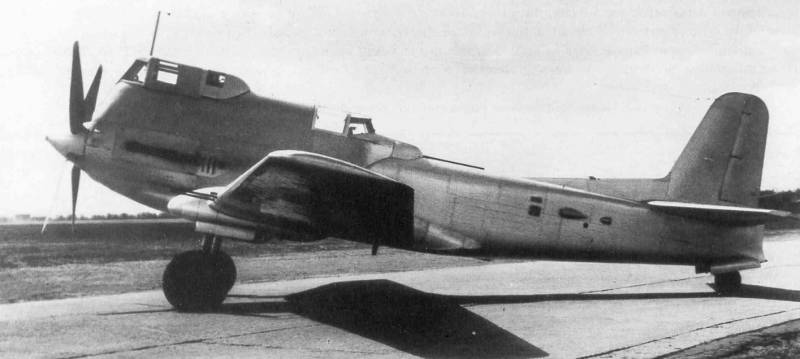
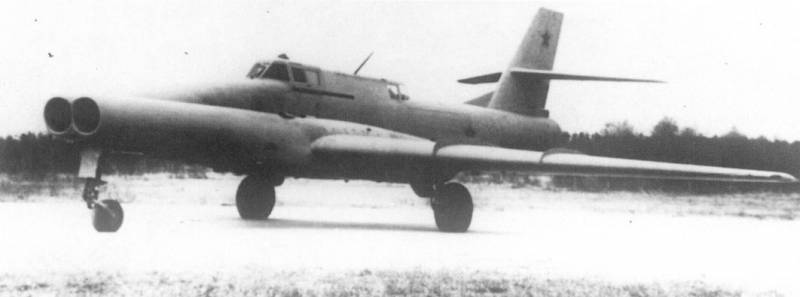
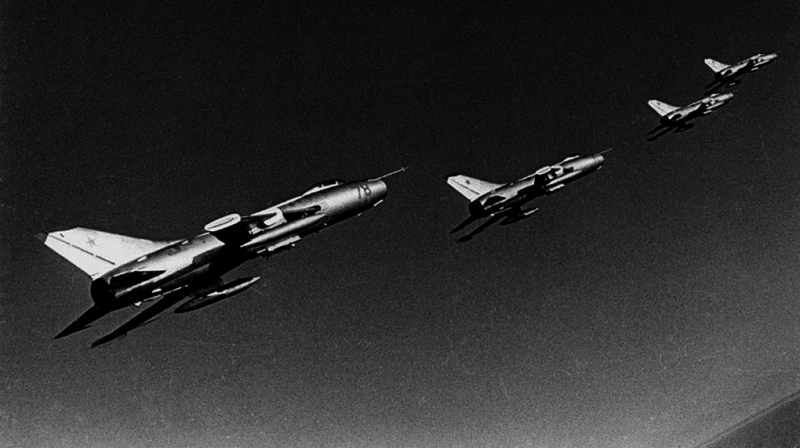
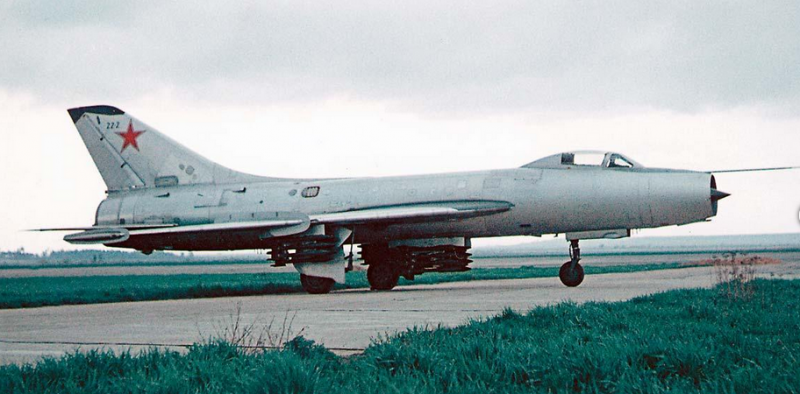
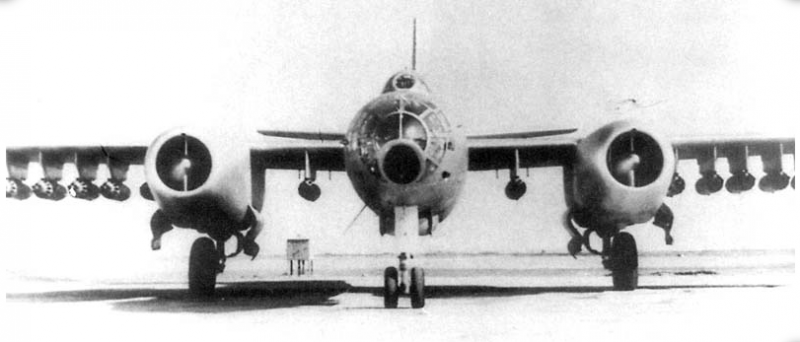
Information